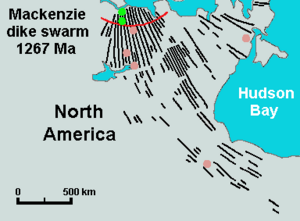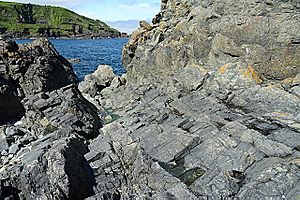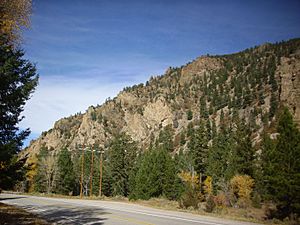Dyke (geology) facts for kids
In geology, a dike (sometimes spelled dyke) is like a wall of rock that forms inside a crack in older rocks. Imagine a big crack in the ground; a dike is what fills that crack.
Dikes can be made in two main ways:
- Magmatic dikes form when hot, melted rock (called magma) flows into a crack and then cools down and hardens.
- Clastic dikes form when loose bits of rock and dirt (called sediment) fill up an existing crack.
Contents
Magmatic Dikes: Walls of Igneous Rock
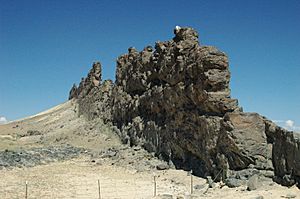
A magmatic dike is a sheet of igneous rock that cuts across older rock layers. It forms when magma (melted rock from deep inside Earth) fills a crack in the older rocks. Then, this magma cools and becomes solid.
Often, the rock that makes up the dike is stronger than the rocks around it. So, as erosion (like wind and water) wears away the softer surrounding rock, the dike stands out like a natural wall or ridge. This is how dikes got their name!
Geologists study dikes because they show how magma travels to the Earth's surface. They are like ancient pipes for volcanoes. Dikes also tell us about times when the Earth's crust was pulled apart. When the crust stretches, many dikes (called dike swarms) can form. These dikes show the direction the crust was stretching.
What Magmatic Dikes Look Like
A dike is usually much thinner than it is long or tall. Its sides are often parallel, meaning it has a fairly constant thickness. Dikes can be as thin as a few millimeters or as thick as hundreds of meters. Most are about one to a few tens of meters thick. They can stretch for tens of kilometers, and some very thick ones can go for over 100 kilometers.
Most dikes stand almost straight up, meaning they are nearly vertical. But sometimes, later tectonic movements can tilt the rock layers and the dike, making the dike lie flat.
Sometimes, dikes form in a pattern called en echelon. This means a set of dikes are arranged like overlapping steps. Each dike might be a few kilometers long, but they line up to form a much longer feature. For example, the Higganum dike set in New England has individual dikes about four kilometers long. These shorter dikes form longer groups that stretch for about 10 kilometers. The entire set of dikes forms a line that is 250 kilometers long!
Dikes can be made of different types of rock, from basalt (dark, fluid magma) to rhyolite (lighter, thicker magma). Most dikes are basaltic. The rock inside a dike often has a slightly coarser texture than lava that erupts on the surface. This rock type is called diabase.
The size of the mineral grains in a dike changes from the edges to the center. The largest grains are usually in the middle. Dikes that form close to the surface often have a glassy or very fine-grained chilled margin (a thin edge, 1 to 5 cm thick). This happens because the magma cools very quickly when it touches the cold surrounding rock.
Shallow dikes also often show columnar jointing. This is when the dike rock cracks into columns (like pillars) as it cools and shrinks. These columns usually have 5 or 6 sides, but 3 or 4-sided columns are also common. They are usually uniform in size within one dike, but can range from a few centimeters to over 0.3 meters across in different dikes. Wider dikes tend to have larger columns because they cool slower.
Dike rock is usually dense, with almost no vesicles (frozen gas bubbles). But sometimes, bubbles can be seen in the shallowest parts of a dike. If bubbles are there, they often form bands parallel to the dike walls. Also, larger crystals (called phenocrysts) near the edges of the dike often line up in the direction the magma flowed.
It's important to know that dikes cut across the layers of older rock. A sill, on the other hand, is a sheet of igneous rock that forms between and parallel to the layers of rock.
How Magmatic Dikes Form
Magma that is fluid and low in silica (a common mineral) usually reaches the surface through cracks, forming dikes.
Near the surface, dikes form when magma rises into cracks that already exist. For example, in the Hawaiian Islands, young dikes don't show signs that the magma forced its way in. This suggests the cracks opened because the ground above a magma chamber (a pool of magma) was bulging as it filled up.
However, open cracks can only exist close to the surface. Deeper down, magma has to push its way through the rock. It always opens a path where the rock is under the least pressure. At shallow depths, where rock is brittle (can break easily), the magma breaks the rock as it moves up. Even a little pressure from the magma can create huge stress at the tip of the crack. This process is called hydraulic fracture, where the magma essentially wedges the rock apart.
Deeper down, where the rock is hotter and less brittle, the magma pushes the rock aside along planes that are angled about 35 degrees from the dike's sides. This is like a bulldozer action. At the deepest levels, these planes become ductile (meaning the rock can bend without breaking), angled 45 degrees from the dike's sides. At depths where the rock is completely plastic (can flow), a diapir (a rising blob of magma) forms instead of a dike.
The walls of dikes often fit together perfectly, which strongly suggests the dike formed by a crack opening up. But some very large dikes, like the 120-meter-thick Medford dike in Maine, US, don't show this. These might have formed by stoping, where the magma broke apart and dissolved the rock at its tip instead of prying it open. Other dikes might have formed by metasomatism, where fluids moving along a narrow crack changed the chemicals in the rock closest to the crack.
When magma flows quickly through a crack, it can erode the walls. This can happen by melting the wall rock or by tearing off pieces of it. This makes the crack wider and increases the magma flow. If the flow is slower, the magma might cool and harden next to the wall, making the crack narrower and slowing the flow. This causes the flow to focus on just a few spots. In Hawaii, eruptions often start with a "curtain of fire," where lava erupts along a crack several kilometers long. But over time, the eruption usually shrinks to a much shorter segment.
Multiple and Composite Dikes
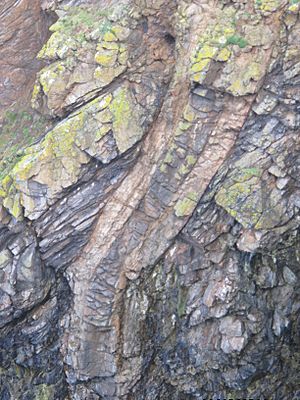
Sometimes, magma flows into the same crack more than once.
- If all the magma injections are similar, it's called a multiple dike.
- If later magma injections are very different in type, it's called a composite dike. For example, a composite dike might have both diabase (dark, fine-grained) and granite (light, coarse-grained) rock.
After a dike first forms, later magma injections usually happen along the center of the dike. If the first dike rock has cooled a lot, the new magma might fracture the old dike rock. It will also form new chilled margins where it touches the older, cooler dike rock.
Dike Swarms: Many Dikes Together
Sometimes, many dikes appear together in groups called dike swarms. These swarms can have from a few to hundreds of dikes that formed around the same time. Dike swarms are almost always made of diabase rock. They are often found with flood basalts, which are huge outpourings of lava that cover large areas. Dike swarms are common where divergent plate boundaries (where Earth's plates pull apart) are forming. For example, dike swarms in New England and Scotland show where the Atlantic Ocean started to open up a long time ago.
Today, dike swarms are forming in Iceland, where a divergent plate boundary runs through the country. Dike swarms can have a huge total thickness. In Iceland, dikes are typically 3 to 5 meters wide. One 53-kilometer stretch of coast has about 1000 dikes with a total thickness of 3 kilometers! The world's largest dike swarm is the Mackenzie dike swarm in Canada.
Dike swarms are also found in the eroded (worn-away) rift zones of Hawaiian volcanoes. These dikes were the cracks through which lava reached the surface. These swarms are usually 2.5 to 5 kilometers wide, with individual dikes about a meter wide. They spread out like spokes from the volcano's top. In the center of a rift zone, there might be 50 to 100 dikes per kilometer. The density can be as high as 500 dikes per kilometer, meaning dikes make up half the rock volume! Further from the center, the number of dikes drops.
Dikes often form in radial swarms, spreading out from a central volcano or a large magma body. Even though they seem to come from the center, the dikes might be a different age and type of rock than the central body. These radial swarms might have formed over the magma body and were later cut by it. Or, the crust was already stretching, and the magma body just triggered the cracks to form.
Sheeted Dike Complexes
In the rock that makes up the ocean floor, pillow lava (lava that looks like stacked pillows) is found on top of sheeted dike complexes. These complexes are like a stack of dikes that show the paths magma took to reach the ocean floor at mid-ocean ridges (underwater mountain ranges where new crust is made). These dikes often have a chilled margin on only one side. This means each dike was split in half by a new eruption of magma.
Ring Dikes and Cone Sheets
Ring dikes and cone sheets are special types of dikes that form around caldera volcanoes. A caldera is a large, bowl-shaped hollow that forms when a volcano collapses. These dikes are found around a shallow magma chamber.
- Cone sheets form when magma pushes into a shallow magma chamber. This lifts and cracks the rock layers above it. The cracks form a set of cones that dip (slope) inward towards the magma chamber.
- Ring dikes form when a caldera collapses after a big eruption. The roof of the magma chamber falls in, creating a ring-shaped crack. Magma then rises into this crack, forming a ring dike. Good examples of these are in Scotland.
Other Special Dike Types
A feeder dike is a dike that acted like a pipe, carrying magma from a magma chamber to a smaller, localized intrusion (where magma pushes into existing rock). For example, a large intrusion in arctic Canada was fed by a dike 150 meters thick.
A sole injection is a dike that forms along a thrust fault plane. This is where rock layers are fractured and pushed up over younger layers.
Clastic Dikes: Sediment Walls

Clastic dikes (also called sedimentary dikes) are vertical bodies of sedimentary rock that cut across other rock layers. They can form in two main ways:
- Fluid Pressure: Sometimes, shallow, loose sediment has layers of coarse grains (like sand) mixed with layers of clay that water can't pass through easily. If the water pressure inside the sandy layers gets too high (because of the weight of the rock above), the sediment can break through the layers above it and form a dike.
- Frozen Ground: When soil is in permafrost conditions (meaning the ground is permanently frozen), the water in its pores is completely frozen. If cracks form in this frozen ground, they can fill up with sediments that fall in from above. This creates a vertical body of sediment that cuts through horizontal layers, forming a dike.
Gallery
-
Vertical basalt dikes cutting horizontal lava flows, Lord Howe Island, Australia
-
Dark dikes on Baranof Island, Alaska
-
Magmatic dikes radiating from West Spanish Peak, Colorado, U.S.A.
-
Sheeted clastic dike in Missoula flood slackwater rhythmites at Cecil, Oregon
See also
 In Spanish: Dique (geología) para niños
In Spanish: Dique (geología) para niños




